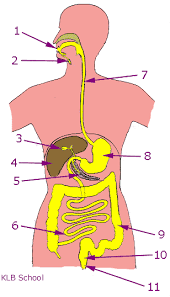SCIENCE
1. DIGESTIVE SYSTEM
READ THE DIGESTIVE SYSTEM STORY AND IDENTIFY ORGANS AND ACTIONS.
DIGESTIVE SYSTEM STORY
KEY WORDS :
LABEL THE ORGANS:

Read the story and connect the organs with the actions
ORGANS ACTIVITY REVISION

BODY SYSTEM WORD FIND
ONCE UPON A TIME 1/3
2/3
3/3
KEY WORDS:
MAKE THE ACTIONS:
CHEW, CHURN, SWALLOW, FILTERS, PRODUCE, BREAK DOWN, PUSH DOWN, STORE, PUSH OUT, TAKES WATER OF
MORE KEY WORDS: SALIVA, GASTRIC JUICES, ENZYMES,
GLOSSARY HELP
hotspots
WHAT IS DIABETES?
IS THERE ANY CURE FOR DIABETES?
THE FOOD YOU EAT IS TURNED INTO.....................
AND THIS TRAVELS TO ALL YOUR CELLS THROUGH THE .............
WHICH IS THE ORGAN INVOLVED?
WHAT DOES THIS ORGAN PRODUCE?
HOW DOES INSULIN HELP OUR BODY?
WHY DO OUR CELLS NEED GLUCOSE FOR?
WHAT HAPPENS IF YOU HAVE DIABETES?
WHAT ARE THE SYMPTOMS?
IS THERE ANY TREATMENT FOR DIABETES? IF SO, WHICH ONE?
MOVIE. DIGESTIVE SYSTEM
https://www.bbc.com/bitesize/topics/z27kng8
EXPERIMENT 1 ON ENZYMES:
MATERIALS:
FOUR DROPS OF IODINE, SLICES OF BREAD, WAX PAPER AND SALIVA.
INSTRUCTIONS
First, from a slice of white bread, cut two small pieces about one-inch square.
1 inch = 2.54 cm.
Then, place one piece in your mouth and chew it 30 times. It will become very mushy. Mix as much saliva as possible.
Next, spit the mushy bread and saliva mixture onto a piece of wax paper.
Then, place the second dry piece of bread on a separate piece of wax paper.
Finally, add four drops of iodine to both bread pieces.
OBSERVATION AND RECORDS:
I observed that......
VARIABLE: (This is what we changed in the experiment. Just one thing at a time).
The variable is ..........
CONCLUSIONS:
I conclude that ...
SALIVA
CLICK THE FOLLOWING LINKS IF YOU WANT TO KNOW MORE INFORMATION ABOUT THE DIGESTIVE SYSTEM
DIGESTIVE SYSTEM
e-learning digestive system
digestive system builder
yucky digestive system
CLICK ON DIGESTIVE ANIMATION AND YOU WILL SEE HOW DIGESTIVE SYSTEM WORKS WHEN YOU EAT DIFFERENT FOOD.
Digestion animation
1. DIGESTIVE SYSTEM
READ THE DIGESTIVE SYSTEM STORY AND IDENTIFY ORGANS AND ACTIONS.
DIGESTIVE SYSTEM STORY
KEY WORDS :
LABEL THE ORGANS:
Read the story and connect the organs with the actions
ORGANS ACTIVITY REVISION

BODY SYSTEM WORD FIND
ONCE UPON A TIME 1/3
2/3
3/3
KEY WORDS:
MAKE THE ACTIONS:
CHEW, CHURN, SWALLOW, FILTERS, PRODUCE, BREAK DOWN, PUSH DOWN, STORE, PUSH OUT, TAKES WATER OF
MORE KEY WORDS: SALIVA, GASTRIC JUICES, ENZYMES,
GLOSSARY HELP
| HOW TO MAKE A GLOSSARY IN GROUPS. TIPS:
BUT DON'T COPY!! YOU MUST USE YOUR OWN WORDS!!!! |
| Glossary help for kids |
Mouth: teeth (chew)
Gullet or esophagus:(Swallow down)
Stomach:(Churns)
Small Intestine:(Breaks down and absorbs)
Liver:(Produce and Filter
Pancreas:(Produces)
Gall bladder:(store)
Large intestine:(Takes water out of and pushes down)
Anus:(Pushes out)
hotspots
WHAT IS DIABETES?
IS THERE ANY CURE FOR DIABETES?
THE FOOD YOU EAT IS TURNED INTO.....................
AND THIS TRAVELS TO ALL YOUR CELLS THROUGH THE .............
WHICH IS THE ORGAN INVOLVED?
WHAT DOES THIS ORGAN PRODUCE?
HOW DOES INSULIN HELP OUR BODY?
WHY DO OUR CELLS NEED GLUCOSE FOR?
WHAT HAPPENS IF YOU HAVE DIABETES?
WHAT ARE THE SYMPTOMS?
IS THERE ANY TREATMENT FOR DIABETES? IF SO, WHICH ONE?
| FIND THE ANSWERS ON THE WEBSITE harcourtschool.com copy the questions into your notebook |
| 1. What liquid do we have in the mouth? |
| 2. What is another name for the esophagus? |
| 3. What does the esophagus do? |
| 4. In the stomach food breaks down into two things, what are they? |
| 5. Where do the nutrients go into the blood? |
| 6. What is another name for the rectum? |
| 7. What is the rectum made of? |
MOVIE. DIGESTIVE SYSTEM
https://www.bbc.com/bitesize/topics/z27kng8
| The digestive system cartoon | |
Digestive system song | DIGESTIVE SYSTEM SONG LYRICS |
EXPERIMENT 1 ON ENZYMES:
- WE ARE GOING TO DO AN EXPERIMENT.
- WE ARE GOING TO RECORD WHAT WE OBSERVED.
- WE ARE GOING TO WRITE WHAT IS THE VARIABLE IN THE EXPERIMENT.
MATERIALS:
FOUR DROPS OF IODINE, SLICES OF BREAD, WAX PAPER AND SALIVA.
|
|
INSTRUCTIONS
First, from a slice of white bread, cut two small pieces about one-inch square.
1 inch = 2.54 cm.

Then, place one piece in your mouth and chew it 30 times. It will become very mushy. Mix as much saliva as possible.
Next, spit the mushy bread and saliva mixture onto a piece of wax paper.
Then, place the second dry piece of bread on a separate piece of wax paper.
Finally, add four drops of iodine to both bread pieces.
OBSERVATION AND RECORDS:
I observed that......
VARIABLE: (This is what we changed in the experiment. Just one thing at a time).
The variable is ..........
CONCLUSIONS:
I conclude that ...
SALIVA
CLICK THE FOLLOWING LINKS IF YOU WANT TO KNOW MORE INFORMATION ABOUT THE DIGESTIVE SYSTEM
DIGESTIVE SYSTEM
e-learning digestive system
digestive system builder
yucky digestive system
CLICK ON DIGESTIVE ANIMATION AND YOU WILL SEE HOW DIGESTIVE SYSTEM WORKS WHEN YOU EAT DIFFERENT FOOD.
Digestion animation


No hay comentarios:
Publicar un comentario